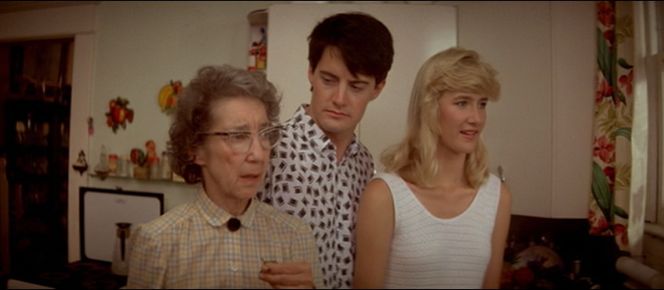 Back to selection
Back to selection
The Blue Velvet Project
Blue Velvet, 47 seconds at a time by Nicholas Rombes
The Blue Velvet Project, #150

Second #7050, #117:30
It’s as if the movie has gone back in time; Jeffrey and Sandy look so young. “I don’t see how they could do that,” Aunt Barbara (Frances Bay) says, looking at the robin on the windowsill with the live bug (perhaps one of the black beetles from the beginning of the film) in its beak, “I could never eat a bug.” She speaks these words just before inserting something black into her mouth.
In The Plague of Fantasies, Slavoj Žižek suggests that
fantasy does not simply realize a desire in a hallucinatory way: rather, its function is similar to that of Kantian ‘transcendental schematism’: a fantasy constitutes our desire, provides its co-ordinates; that is, it literally teaches us how to desire.
How does Blue Velvet teach us how to desire? By punishing Frank, the one whose desires are forbidden. And by punishing Dorothy, who has internalized Frank’s abusive, murderous desires and turned them on herself, as when she commands Jeffrey to hit her during sex. This chain of desire has to stop somewhere, and it’s the robin—and the idea of the robins—that puts an end to it. The mechanized robin is not from our world (“in the dream there was our world, and the world was dark because there weren’t any robins”) but from a movie world: a prop that helps, as Žižek would say, “coordinate our desires.” Maybe it’s not surprising that the film’s answer to the “trouble” of this world and people like Frank is, in fact, otherworldly, transcendental.
And yet that transcendental vision—the robin—is created with and filmed by the material objects and technologies of this world. In this frame at second #7050 Jeffrey’s gaze is directed at his skeptical Aunt Barbara rather than the robin, as if he too shares in her distrust of this bird that Sandy has pinned her hopes on as a symbol of goodness. Jeffrey’s secret affinity with his Aunt Barbara is one of the great dark wrinkles in the film, a fact that no matter how you try to smooth out stays stubbornly present, a gap or fissure in the film’s ideology. Aunt Barbara recognizes the robin for what it is, but what the film cannot say it is. For sometimes a film’s meanings escape the boundaries of the film itself, and it’s almost miraculous when this happens.
That’s where transcendence lies: not in what the robin is supposed to signify, but in the failure of that very signification.
Over the period of one full year — three days per week — The Blue Velvet Project will seize a frame every 47 seconds of David Lynch’s classic to explore. These posts will run until second 7,200 in August 2012. For a complete archive of the project, click here. And here is the introduction to the project.
